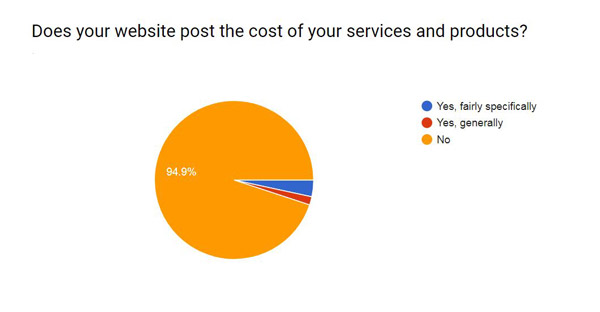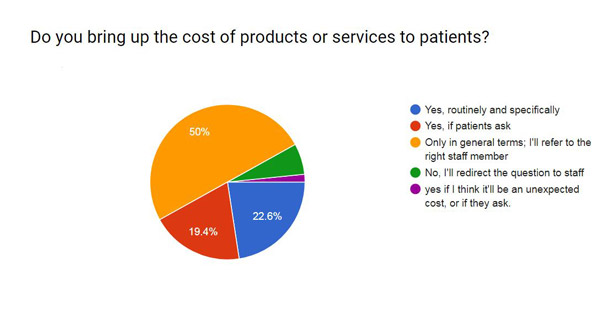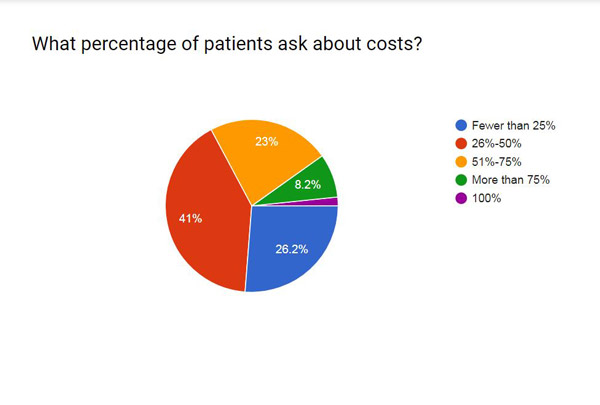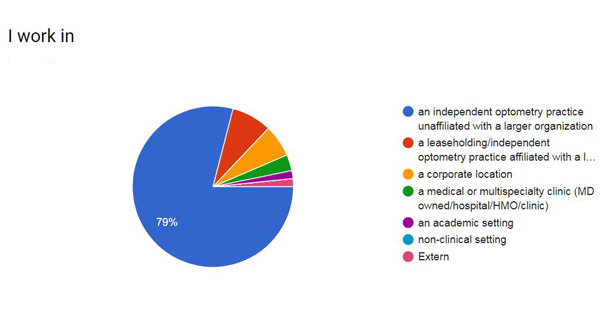Cost is a factor to many patients, but pricing information can be hard to find
About one-third of the respondents to a recent Women In Optometry Pop-up Poll said that at least half of their patients ask questions about the cost of services. Yet only about five percent of respondents say that they include information about their charges and costs on their websites. Certainly, there’s complexity in some aspects of pricing in an optometric practice, but that doesn’t stop patients from asking.


Fewer than one-quarter of the respondents (22 percent) said that they’ll bring up pricing routinely and specifically. Another 19 percent said that they will do so if the patient asks. Fully 50 percent of the OD respondents said that they will refer the patient with questions to an appropriate staff member.


However, many patients seem to be asking questions about pricing. While 26 percent of respondents said only a relatively small number (fewer than one-in- four patients) have questions about costs, another 41 percent said that between one-quarter and one-half of patients ask about costs. Twenty-three percent said that between one-half and three-quarters of patients have questions; eight percent said that more than 75 percent of patients ask about costs and two percent said all of them do.


Patients almost always ask the doctor directly about pricing, said respondents, with 69 percent of respondents said that patients will “sometimes” ask doctors about costs and 29 percent said that they ask doctors about costs “often.” But patients are asking the questions of other staff members, too.
• Fifty-two percent of respondents said patients ask the receptionist or front desk staff about costs.
• Forty-five percent said that patients ask opticians about costs.
• Twenty-nine percent said that patients ask technicians about costs.


The majority of the respondents, (79 percent) said that they work in independent, unaffiliated optometry practices. Another eight percent said that they are leaseholders with a larger company, and seven percent said they are in a corporate-affiliated practice. Three percent are in a multispecialty, MD-owned clinic or hospital setting, and two percent are in an academic setting.
Respondents shared some of ideas on big a factor cost is to patients’ decision to come to the practice.
“Probably bigger than I (the doctor) think.”
“We are a heavy contact lens and surgical practice (OD/OD) group so I talk price A LOT!”
“With high deductible health plans, it can be a HUGE factor for patients determining where to go for health services. We have a list we hand our patients when I request ‘special testing,’ such as threshold visual fields, OCT, LipiView/LipiFlow, topography and other tests.”
“Probably cost is not as important as that we accept their insurance and that our online reviews are good.”
“Not a factor.”
“I don’t take most insurances. No vision plans”
“Since our recent relocation from corporate affiliate to private, our patients are coming for the quality service we provide even though we are no longer on their vision plans.”
“My office is in a low -income town. Patients often say, ‘I only want what’s covered.’ ‘What do you mean I have a co-pay for this or that?’”
“It’s a factor in the decision-making of many patients in the practice. However, the over-riding factor is performance and problem-solving. Even if the expense of a service or product is greater than expected or desired, it is most often pursued because a problem or ‘pain point’ is being addressed.”
“Moderate”
“There were a few who chose not to come to the practice because our fees were more than the average in town. However, those who came in were more concerned with our reputation then the cost.”
“Overall, I’d say moderate.”
“Very big”
“Cost is a big factor. I have a goodly amount of Medicare and Medicaid patients.”
“Smaller factor. My services are ‘specialty services’/ tertiary care. My patients are happy when insurance pay some of the cost but they continue care despite the amount covered.”
“Often significant, but not always the deciding factor.”
“Not a big deal.”
“Somewhat”
“It is not a big factor in most cases.”



